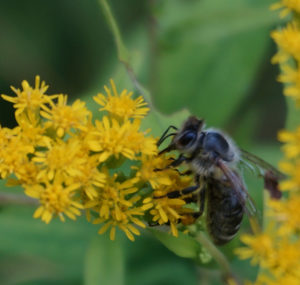Bee Lines: Honey bees – an introduction
by Sam Hall –
Writing and talking about honey bees is one of the things I love to do. To understand honey bees we have to look a little at their history, which is part of the larger picture of pollinators generally. In the prehistoric times when the dinosaurs ruled the earth there wasn’t much growing but conifers and swamp grass but then flowering plants appeared and at the same time a group of flying insects called predatory wasps took to the air and developed a symbiotic relationship with the flowers. One could not survive without the other. The insects carry the pollen from one flower to another causing pollination and use the surplus pollen to feed their young. The nectar they gather also from the blossoms honey bees store and it becomes honey. We are the beneficiaries of this symbiotic relationship for without it we would not have fruits and vegetables and even meat because most cattle depend on crops the bees pollinate. It has been said that if the pollinators disappeared within three years we would also. I believe that.
At the end of World War II the US had six million colonies of honey bees, today the best estimates are two and a quarter million and the numbers continue to go down. There is no single reason for this but it is the result of many factors that are resulting in the perfect storm. I will not discuss the reasons at this time as I want to talk about honey bee basics.

There are three kinds of honey bees in a colony: the queen, the workers (female) and the drones (male). When I use the word “colony” I am speaking about the bees themselves and when I use the term “hive” I am talking about the physical boxes, trees or anything else the colony is living in.
The queen is the mother of all the bees in the colony. Books have been written about queen bees but for our purposes here I will only mention a few things about
this unique insect. She emerges from a specially designed cell made for her by the bees and when she emerges she cannot fly as she needs to get her wings in flying shape, which can take three to five days or more. Thereafter she will go on her mating flights. She will go to a drone congregation area where she will mate with hopefully at least 20 drones. This is done over a period of three or more days after which she will never mate again.
The workers are all female and they hold many jobs during the course of their lives some of which are childcare, housekeeping, foraging and guarding.
The drones have one purpose in life and that is to mate with a virgin queen. Mating is done about 75 feet in the air and when the drone separates from the queen after the coupling his penis stays in the queen and his innards are pulled out with it and he dies.
I look forward to writing more about bees in future OWL editions, and am happy to answer bee-related questions from readers.